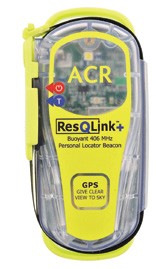By Vincent Pica, Commodore, First District, Southern Region (D1SR), United States Coast Guard Auxiliary
 When the perfectly calm day sneaks up on you while you are daydreaming and turns into a snarly, life-stealing beast, all your training rushes to the front of the “screen.” But sometimes, all your skill isn’t going to get you home. And sometimes the boat itself is what betrays you as she threatens to slip away beneath you. You are going to be hard to find – unless you are sending a personal signal to the satellite that will call the U.S. Coast Guard for you. This column is about that.
When the perfectly calm day sneaks up on you while you are daydreaming and turns into a snarly, life-stealing beast, all your training rushes to the front of the “screen.” But sometimes, all your skill isn’t going to get you home. And sometimes the boat itself is what betrays you as she threatens to slip away beneath you. You are going to be hard to find – unless you are sending a personal signal to the satellite that will call the U.S. Coast Guard for you. This column is about that.
This pocket-sized device just might save your life. © acrartex.com
Trained in Saving Yourself
Among the various locator devices is one that used be known as a Personal EPIRB or “PPIRB.” This is what we now call a “PLB” or Personal Locator Beacon. You wear it on your person. It also has a built-in GPS. When you attain a coxswain rating in the USCG Auxiliary (the person responsible for the boat, the crew and the mission), the USCG gives you a PLB: “Even if you go hiking, take this with you. If you get lost, we’ve got too much invested in you not to come get you!” Be aware that there are private companies now that offer devices that can locate you while you are underway and offer rescue notification services. I have no fully formed opinion of them, pro or con, but if I am not registering myself and my device with NOAA (beaconregistration.noaa.gov/), then I have to figure that my call for help has to pass through at least one additional set of hands…
Back in the day…
The old model EPIRBs transmitted on dual frequencies of 121.5 and 243 megahertz (MHz). This was hopefully picked up by passing planes and satellites. It could take four to six hours for someone or something to pass overhead before it reached the USCG. Also, the footprint that you were within could be as much as 12 square nautical miles. That is a square 12nm long and 12nm miles wide. That’s a lot of water to cover. On the USCG website (navcen.uscg.gov/marcomms/gmdss), it says that the 121.5/243MHz devices are “no longer recommended.”
The State of the Art…
Interestingly, the 121.5MHz frequency is favored for radio direction finding (RDF), so the newest EPIRBs now transmit simultaneously on 406MHz and 121.5MHz. The 406MHZ reduces the footprint to 1 square nautical mile. It’s heard by satellites all over the world and, within an hour, the USCG Rescue Coordination Centers will have commenced coming to your aid. And the rescuers will also be looking for your EPIRB’s 121.5MHz signal with their RDF gear. In heavy seas, that may very well be the difference between passing right by you while you are in the trough or knowing that you are just over the next wave.
But my boat has an EPIRB
Good! I just hope you don’t fall off the boat… Or, as the tale below details, your EPIRB battery, which you dutifully replaced (as I just did!) by shipping it to the lowest-cost provider of battery replacement services that could be found on the internet, doesn’t fail at the time that it is most needed – as you grab it in an abandon ship scenario…
From Ocean Navigator, 3/16/2010
I read everything about the sea that I can get my hands on – hard copy, electronic, notes in bottles… Back in 2010, Ocean Navigator magazine published a story by Fredrick Gary Hareland about this same subject and I saved it as an object lesson. Mr. Hareland recounted in his story the following about the crew of a 57-foot vessel making way from Hong Kong to Phuket when disaster struck:
“In closing, I must inform you that our crew and passengers on board that 57-footer were all rescued thanks to the master’s back-up PLB. Turns out the EPIRB failed to deploy, but that little handheld PLB got the alert through and the victims are toasting it and each other while retelling their recent adventure.”
Redundancy will look very cheap and very smart, if/as/when…and they fit in your pocket.
If you are interested in being part of the USCG Forces, email me at JoinUSCGAux@aol.com or go direct to the D1SR Human Resources department, who are in charge of new members matters, at d1south.org/StaffPages/DSO-HR.php and we will help you “get in this thing.”
The Acting Commander for U.S. Coast Guard Sector Long Island Sound is Commander Kevin Reed. CDR Reed is responsible for all active-duty, reservist and auxiliary Coast Guard personnel within the Sector. As a Commodore of the U.S. Coast Guard Auxiliary First District, Southern Region, Vin Pica works closely with CDR Reed and his staff to promote boating safety in the waters between Connecticut, Long Island and 200 nautical miles offshore. Sector Long Island Sound Command Center can be reached 24 hours a day at 203-468-4401.




